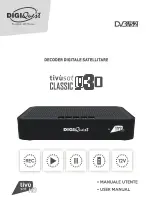
Precauciones
Ubicación
El uso de la unidad en las siguientes ubicaciones puede dar como resultado un mal funcionamiento:
• Expuesto a la luz directa del sol
• Zonas de extremada temperatura o humedad
• Zonas con exceso de suciedad o polvo
• Zonas con excesiva vibración
• Cercano a campos magnéticos
Fuente de alimentación
Apague la unidad cuando no la use la batería. Retire las baterías si no va a usar la unidad durante un
tiempo largo.
Interferencias con otros aparatos
Las radios y televisores situados cerca pueden experimentar interferencias en la recepción. Opere este
dispositivo a una distancia prudencial de radios y televisores.
Manejo
Para evitar una rotura, no aplique excesiva fuerza a los conmutadores o controles.
Cuidado
Si exterior se ensucia, límpiese con un trapo seco. No use líquidos limpiadores como disolvente, ni
compuestos inflamables.
Guarde este manual
Después de leer este manual, guárdelo para futuras consultas.
Mantenga los elementos externos alejados del equipo
Nunca coloque ningún recipiente con líquido cerca de este equipo, podría causar un cortocircuito, fuero o
descarga eléctrica. Cuide de que no caiga ningún objeto metálico dentro del equipo.
Nota respecto a residuos y deshechos (solo UE)
Cuando aparezca el símbolo del cubo de basura tachado sobre un producto, su manual de
usuario, la batería, o el embalaje de cualquiera de éstos, significa que cuando quiere tire
dichos artículos a la basura, ha de hacerlo en acuerdo con la normativa vigente de la Unión
Europea. No debe verter dichos artículos junto con la basura de casa. Verter este producto
de manera adecuada ayudará a evitar daños a su salud pública y posibles daños al
medioambiente. Cada país tiene una normativa específica acerca de cómo verter productos
potencialmente tóxicos, por tanto le rogamos que se ponga en contacto con su oficina o
ministerio de medioambiente para más detalles. Si la batería contiene metales pesados por
encima del límite permitido, habrá un símbolo de un material químico, debajo del símbolo del
cubo de basura tachado.
NOTA IMPORTANTE PARA EL CONSUMIDOR
Este producto ha sido fabricado de acuerdo a estrictas especificaciones y requerimientos de voltaje
aplicables en el país para el cual está destinado. Si ha comprado este producto por internet, a través de
correo, y/o venta telefónica, debe usted verificar que el uso de este producto está destinado al país en
el cual reside.
AVISO: El uso de este producto en un país distinto al cual está destinado podría resultar peligroso y
podría invalidar la garantía del fabricante o distribuidor.
Por favor guarde su recibo como prueba de compra ya que de otro modo el producto puede verse
privado de la garantía del fabricante o distribuidor.
Where to attach the clip
You can use this tuner to tune woodwind, brass, and string instruments,
but the recommended location for attaching the tuner to your instru-
ment when using the Piezo of the included clip will depend on the type
of instrument that you are using.
Refer to the table on the other side of this sheet and to the illustrations
on the right, and attach the tuner to the recommended location. De-
pending on the conditions of use, you may also be able to tune with the
tuner attached in a different location. You can also switch the input to
the internal mic (Mic) and attach the tuner to a music stand rather than
to your instrument. If you've selected the internal mic, you can also use
the tuner without the clip.
Please carefully attach the AW-2+ to your instrument. Leaving the AW-
2+ attached for a long time may damage or mark the instrument's surface.
If the internal microphone does not seem to pick up the sound very well,
adjust the position and/or angle of the unit.
Recommended locations for attachment
Instrument name
Clip
Attachment
Illustration Remarks
Large Small
location
Trumpet / Cornet
Main tube
A1
Bell (top)
A1
Trombone
Mouthpiece receiver
Bell (top right)
A2
*1
Horn Single
First tube
Double
Bell body
A3
Tuba
Mouth pipe
A4
Euphonium
Bell
A5
Flute
—
—
*2
*3
Oboe
Bell body
A6
E
Clarinet
Bell joint area
B
Clarinet
Bell
A7
Bass clarinet (B
)
Blowing tube
Bassoon
Wing joint area
A8
Soprano saxophone
Bell
Alto Saxophone
Neck / Main tube
A9
Tenor saxophone
Neck
Baritone saxophone
Bell
Violin
Head
B1
Viola
Head
B1
Cello
Tailpiece
B2
Contrabass
Tailpiece
B2
Music Stand
—
—
As desired
C1
*3
*1 Use the reverse function.
*2 Instead of attaching the AW-2+ to the instrument, place the AW-2+ in
a location for convenient viewing and use the internal mic.
*3 Press the input select button to switch to the internal mic (Mic).
When using the AW-2+ and the clip, damage may occur if you apply ex-
cessive force to any other movable portion or joint, or attempt to move it
beyond its intended range of motion.
Large Clip
Small Clip
Examples of using the joint
Range of movement
approximately 100
°
Range of
movement 360
°
Oboe / Hautbois / Oboe
Oboe
A6
French horn / Cor
Horn / Trompa
A3
Trumpet / Trompette
Trompete / Trompeta
A1
Trombone
Trombone
Posaune
Trombón
A2
Violin / Violon / Violine
Violín
B1
Bassoon / Basson
Fagott / Fagot
A8
Clarinet / Clarinette
Klarinette / Clarinete
A7
Tuba / Tuba
Tuba / Tuba
A4
Euphonium / Basse
Tenorbaß
Euphonium
A5
Alto Saxophone
Saxophone alto / Altosaxophon
A9
Saxofón alto
Cello
Violoncelle / Violoncello
Cello
B2
Music stand / Pupitre
C1
Notenständer
Atril musical






















